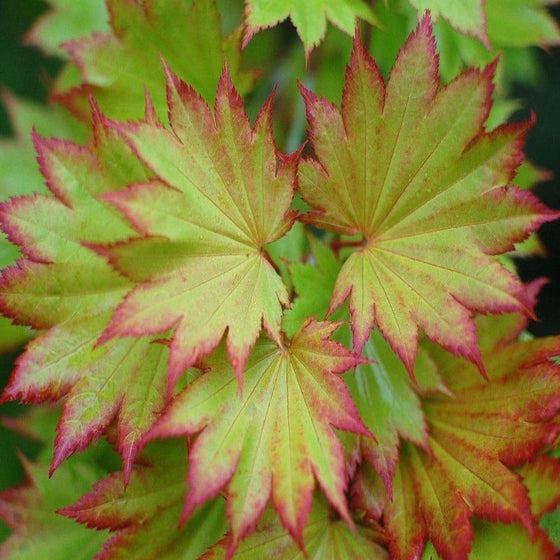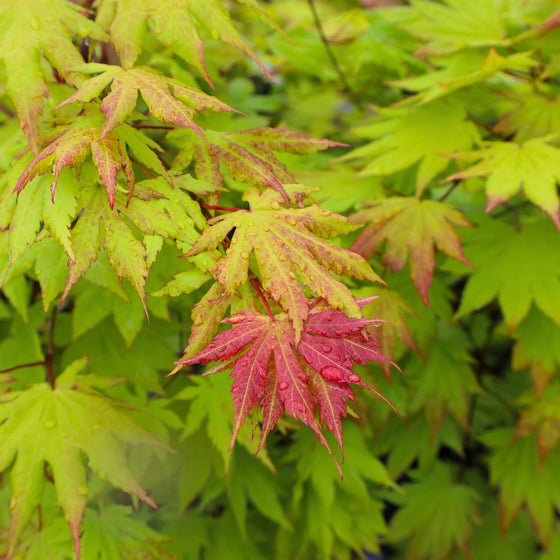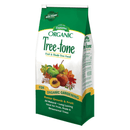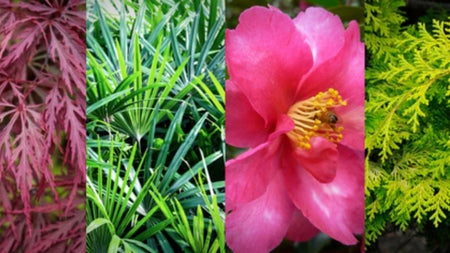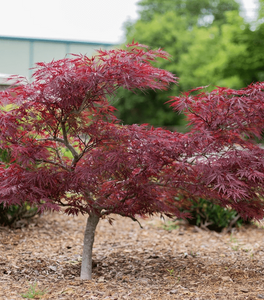
Images Depict Mature Plants
Autumn Moon Japanese Maple Trees for Sale Online
Autumn Moon Japanese Maple (Acer shirasawanum 'Autumn Moon') is a stunning ornamental tree known for its uniquely colored foliage and compact, graceful form. The leaves of this Japanese maple emerge in spring with a striking blend of yellow, orange, and red, creating a vibrant display that continues to shift in hue throughout the growing season. In summer, the foliage takes on a golden tone with hints of orange and pink, while in fall, the colors intensify to brilliant shades of red and orange. This small deciduous tree, reaching 10 to 12 feet tall and wide, is perfect for adding a burst of color to garden beds, patios or as a focal point in a small landscape.
Autumn Moon Japanese Maple thrives best in partial shade, where it can be protected from the intense afternoon sun that may scorch its delicate leaves. It prefers well-drained, slightly acidic soil and benefits from a layer of mulch to maintain moisture and keep the roots cool. The tree's slow to moderate growth rate and rounded form make it an excellent choice for use in Japanese-style gardens, woodland borders, or as an accent tree in any garden setting. Its multi-seasonal interest, with the vibrant spring and summer colors followed by spectacular autumn hues, makes it a highly desirable addition to any landscape.
Not only is the Autumn Moon Japanese Maple visually captivating, but it is also a relatively low-maintenance tree that is well-suited for both beginner and experienced gardeners. It is resistant to pests and diseases and requires only occasional pruning to maintain its shape and remove dead branches. This tree's unique color palette and elegant growth habit make it a perfect choice for adding depth, texture, and visual appeal to a garden, providing a stunning focal point that transforms with each season. Whether planted in the ground or grown in a large container, Autumn Moon Japanese Maple is sure to add an element of beauty and tranquility to your outdoor space.
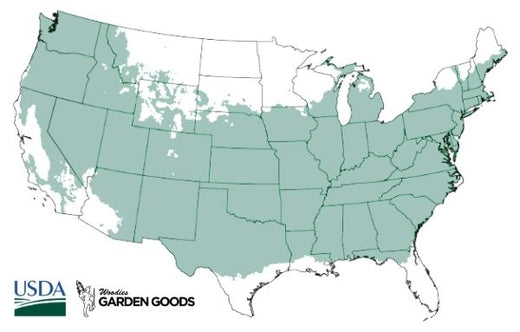
| Hardiness Zone: | 5-8 |
|---|---|
| Mature Height: | 10 to 12 Feet |
| Mature Width: | 10 to 12 Feet |
| Classification: | Medium tree |
| Sunlight: | Sun to shade |
| Habit: | Deciduous, densely branched |
| Flower Color: | Insignificant |
| Foliage: | Yellow with orange red margins |
| Soil Condition: | Any well-drained soil |
| Water Requirements: | Water well until established |
| Uses: | Extremely attractive when used as a focal point or a specimen planting, very slow growing |
How to Care for Autumn Moon Japanese Maple
Once you buy a Autumn Moon Japanese Maple tree, make sure to read about the recommended care instructions to keep this plant healthy and thriving.
How Do I Plant an Autumn Moon Japanese Maple Trees?
To plant an Autumn Moon Japanese Maple tree, start by selecting a site that offers partial shade, as this tree thrives best in locations where it is protected from harsh afternoon sun, which can scorch its delicate leaves. Ensure the soil is well-drained and slightly acidic, as these conditions will help the maple develop its best color and maintain healthy growth. Begin by digging a hole twice as wide and slightly shallower than the root ball of your tree. This allows the roots to spread out easily and prevents the tree from sitting too deep, which could cause root rot. Place the Autumn Moon Japanese Maple in the hole so that the top of the root ball is just above ground level, then backfill with a mix of the native soil and compost. Water thoroughly to settle the soil and eliminate air pockets. Once planted, add a layer of mulch around the base of the tree, leaving a few inches of space around the trunk to prevent rot. This mulch will help retain moisture, keep the roots cool, and suppress weeds. During the first growing season, water your Autumn Moon Japanese Maple deeply and regularly to help establish a strong root system, especially during dry spells. After the tree is established, reduce the watering frequency, but be sure to provide extra water during prolonged periods of drought. Spacing is also crucial—plant Autumn Moon Japanese Maples about 10 to 15 feet apart to allow enough room for their mature spread, ensuring they grow with a natural, open form. With proper planting and care, your Autumn Moon Japanese Maple will reward you with spectacular seasonal color and elegant growth for years to come.
How Do I Water Autumn Moon Japanese Maple Trees?
Watering Autumn Moon Japanese Maple trees properly is essential for their health and vibrant foliage. During the first growing season, water your tree deeply once or twice a week to help establish a strong root system, ensuring the soil stays consistently moist but not waterlogged. Use a slow and deep watering method, such as a soaker hose, which will allow the water to penetrate deep into the root zone. The goal is to keep the top 6-12 inches of soil evenly moist, especially during hot or dry spells. If the tree is planted in well-drained soil, regular watering will promote healthy growth and help the tree produce its signature vibrant leaves. Once established, Autumn Moon Japanese Maple trees become more drought-tolerant, but they still need consistent watering, particularly during prolonged dry periods. Reduce watering frequency, but continue to water deeply, especially during the hot summer months, when the tree may need more moisture to prevent leaf scorch. Mulching around the base of the tree can also help retain soil moisture and keep the roots cool, but make sure to keep the mulch a few inches away from the trunk to prevent rot. Monitoring the soil moisture level by feeling the top few inches of soil will help you determine when it's time to water again, ensuring your Autumn Moon Japanese Maple stays healthy and vibrant year-round.
How Do I Fertilize Autumn Moon Japanese Maple Trees?
Fertilizing Autumn Moon Japanese Maple trees properly will ensure vibrant foliage, healthy growth, and beautiful seasonal color. The best time to fertilize is in early spring, just before the new growth begins. Use a balanced, slow-release fertilizer, such as a 10-10-10 or a 14-14-14 formula, which will provide equal amounts of nitrogen, phosphorus, and potassium. This balanced nutrient supply promotes lush foliage, strong root development, and enhanced color. Spread the fertilizer evenly over the root zone, avoiding direct contact with the trunk to prevent root burn. After applying the fertilizer, water thoroughly to help it soak into the soil and reach the roots effectively. Autumn Moon Japanese Maple trees also benefit from organic fertilizers such as compost, bone meal, or well-rotted manure, which slowly release nutrients and improve soil health over time. Avoid using high-nitrogen fertilizers, as too much nitrogen can lead to overly lush growth that is more susceptible to pests and may reduce the tree's brilliant color display in the fall. For mature trees, fertilizing once a year in spring is usually sufficient, but if the tree shows signs of nutrient deficiency—such as yellowing leaves or stunted growth—an additional light feeding in late spring can help. By maintaining a proper fertilization schedule, your Autumn Moon Japanese Maple will reward you with stunning colors, healthy branches, and robust growth, enhancing the beauty of your garden year after year.

How Do I Prune Autumn Moon Japanese Maple Trees?
Pruning Autumn Moon Japanese Maple trees is essential for maintaining their elegant shape, ensuring healthy growth, and enhancing their natural beauty. The best time to prune your Japanese maple is in late winter or early spring while the tree is still dormant and before new growth begins. Start by removing any dead, damaged, or diseased branches, as well as any crossing or rubbing branches that could cause damage and invite disease. When pruning, focus on thinning out the canopy to improve air circulation and light penetration, which helps reduce the risk of fungal diseases. Always use clean, sharp pruning tools and make cuts just above a node to promote healthy regrowth. When pruning for shape, aim to maintain the tree's natural structure by making selective cuts that enhance its cascading form. Avoid heavy pruning, as this can stress the tree and disrupt its natural growth habit. Instead, prune lightly to remove any stray or awkward branches that may detract from the tree's overall appearance. If you need to control the size of your Autumn Moon Japanese Maple, remove no more than one-third of the total branches in a single season. By following these pruning practices, you can maintain a healthy, beautiful tree with vibrant foliage that adds a striking visual element to your landscape throughout the year.


